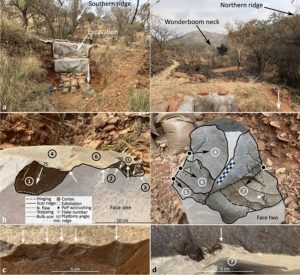Stone Age research
ARCHAEOLOGY @ UJ
A prehistoric period when stone tools first appeared and became the first forms of technology. These tools were formed from stones fashioned into a working edge or a point. In southern Africa, the Stone Age encompasses the longest portion of human history on earth, from the last three million years through to the later part of the stone age. The period lasted for roughly 3.4 million years. Check out some of our Stone Age sites!
Wonderboom, an Earlier Stone Age Acheulian site

Located within the eastern boundary of the Magaliesberg, the research objective of this project is to provide insight into early adaptive strategies of hominin populations to local landscape features.
A project led by Dr Matt Caruana and Professor Marlize Lombard, Wonderboom is situated on top of a quartzite outcrop that was quarried for raw materials used in stone tool production, and it is within ~400 meters of a poort (i.e. an erosional pass) that likely acted as a bottleneck for migrating animal herds in the deep past. The site likely represents a hunting/butchery site, which Acheulean hominins (living in southern Africa between about 1 million and 600,000 years ago) strategically occupied to either actively hunt animals passing through the poort or to scavenge animals that died during such events. Wonderboom may reflect important behavioural adaptations to the landscape, based upon a strategic understanding of geological resources and geographic features.
Amanzi Springs Archaeological Site

Located c. 40 km north of Gqeberha in the Eastern Cape Province of South Africa, Amanzi Springs consists of eleven thermal spring eyes which were initially excavated in the 1960s, these preliminary excavations identified stratified Acheulian layers some of correlated with wood. Currently excavated by Dr Matt Caruana and our Senior Research Associate Professor Andy Herries of La Trobe University in Australia, Acheulian occupations suggest occupation dated to between 530 and 390 ka. Acheulian artifacts from the site suggests that Amanzi Springs represents a raw material source and workshop utilised for the production of large cutting tools. An interesting fact about the site is that it preserves Middle Stone Age (MSA) archaeology which was discovered in a new portion of the site, Area 7. Some Area 1 layers that also contain MSA material have been dated to ~190 ka, the oldest identified along the southern Cape coast of South Africa.
Ancient Human DNA analysis

Our Senior Research Associate Carina Scheblusch alongside our own Prof Lombard and colleagues, have been at the forefront of ancient genomics by using DNA to recalculate the genetic time depth for the origins of our species to between 350-260 thousand years ago, much older than the previously estimated 200-160 thousand-years ago.
This team has pioneered genome analysis by publishing a first-of-its-kind study for Africa, creating unimaginably detailed, personal knowledge about individuals who roamed our past landscapes. This study has demonstrated the ability of science to establish infections such as typhus (Rickettsia felis) and malaria (Plasmodium falciparum), a co-infection still fatal to many African children.
USE-TRACE MICROSCOPY UNIT

Use-trace microscopy unit The PRI boasts a dedicated use-trace microscopy unit overseen by Prof. Justin Bradfield. The P-RI hosts a range of Olympus equipment and specialise in use-wear and non-chemical micro-residue analysis. The facility is open to visiting researchers on request.
SZX16 stereomicroscope: The first port of call for any archaeological magnification requirements, this stereo is equipped with a LED ring illuminator for optimal shadowing conditions.
BX51M high-power reflected light microscope: With full florescence capabilities, polarizing lenses, BF and DF illumination and magnifications up to 1000x, this is the mainstay of the unit.
DSX1000 3D scanning microscope: This 3D scanning microscope has super-long working distance objectives, a tiltable head with telecentric focus and surface roughness measurement capabilities.
DinoLite AM791MZT: Small and portable with polarising capabilities, this is the ideal field instrument for a quick analysis.
